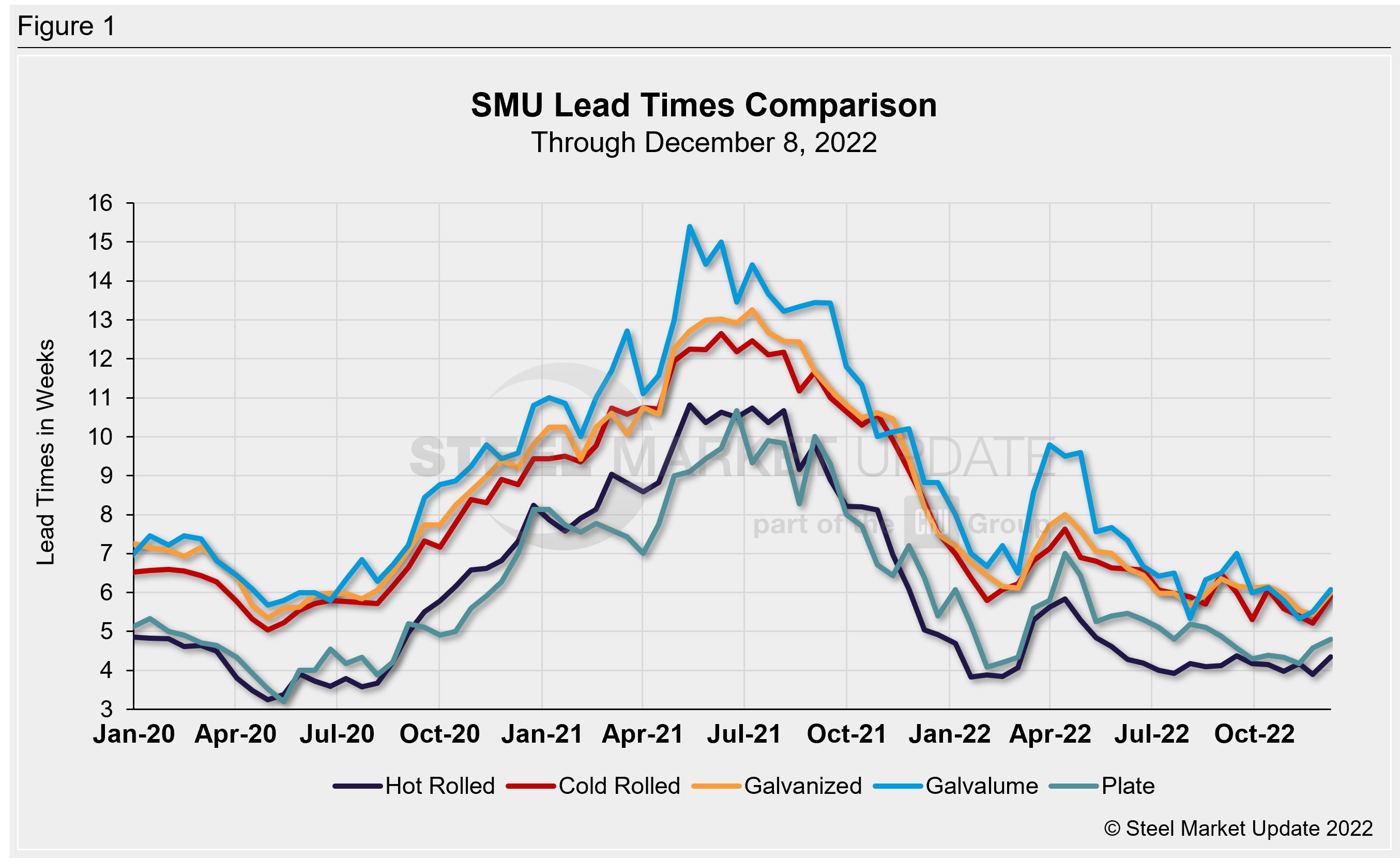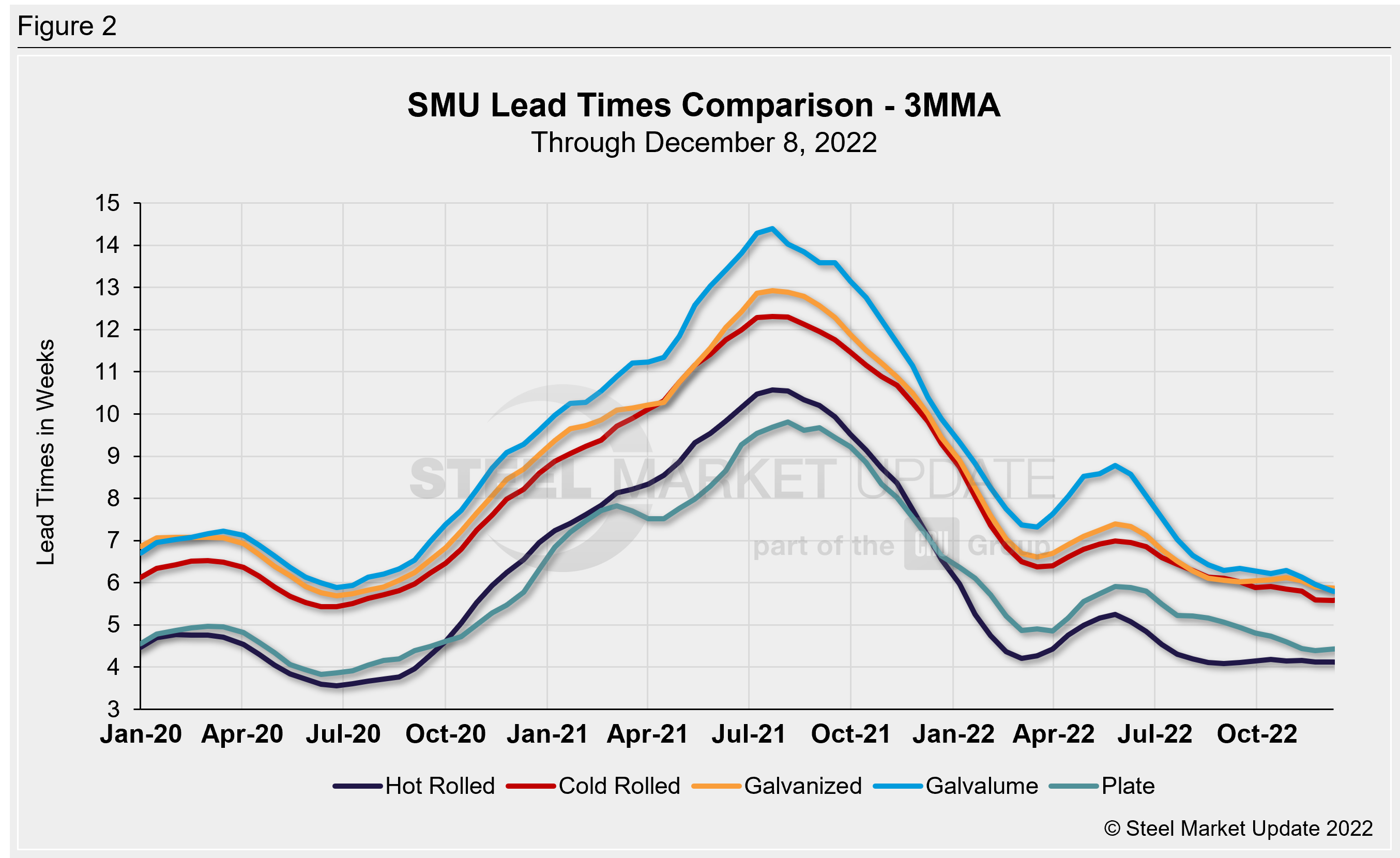Prices

December 8, 2022
Steel Mill Lead Times Change Direction, Extend Modestly
Written by Brett Linton
Steel mill lead times extended across the board this week, with production times increasing for all five products we track. Recall that lead times for hot-rolled, cold-rolled, and galvanized products were previously at or near multi-year lows in our late November market check.
Lead times are up by an average of 0.5 weeks compared to both two weeks prior and one month ago. Following their peak in April, sheet lead times have been relatively stable since July/August. Plate lead times had gradually moved lower over the past six months, ticking up this week in our last two surveys.
Buyers reported mill lead times ranging from 3 to 6 weeks for hot rolled, 4 to 8 weeks for cold rolled, galvanized, and Galvalume, and 3 to 7 weeks for plate.
SMU’s hot-rolled lead time increased by half a week to 4.4 weeks, moving from the lowest level recorded in 18 weeks to the highest level since mid-September. The shortest hot-rolled production time seen this year was 3.8 weeks in January/February. Hot-rolled lead times have averaged between 3.9 to 4.4 weeks since June. Recall the record low in our ~11-year data history was 2.8 weeks in October 2016.
Cold rolled lead times jumped 0.7 weeks to 5.9 weeks, now the highest level since mid-October. We saw the cold-rolled lead times at 5.2 weeks in late November, the lowest recorded since May 2020. One month ago, cold-rolled lead times were at 5.4 weeks.
Galvanized lead times increased 0.6 weeks to 6.0 weeks, now at a six-week high. Like other products, our galvanized lead time in late November was the shortest seen since April 2020. The record low was 4.8 weeks in February 2015.
Galvalume lead times also rose 0.6 weeks to 6.1 weeks. This is up 0.8 weeks compared to levels one month ago, when we saw a 7.5-year low lead time of 5.3 weeks (our record low was in February 2015 at 5.1 weeks). Note that Galvalume figures can be volatile due to the limited size of that market and our smaller sample size.
Plate lead times rose 0.2 weeks to 4.8 weeks, now the longest production time seen since early September. Recall the early November reading of 4.2 weeks was the lowest lead time recorded since February (4.1 weeks). In our four-year history, the shortest plate lead time we have on record was 3.2 weeks in May 2020.

When asked about the future direction of lead times, 57% of the executives responding to this week’s questionnaire expect lead times to be relatively flat into February. This is up from a rate of 50% from our previous survey. 36% of buyers believe lead times will be extending, down from 46% compared to two weeks ago. 6% expect lead times to contract, in line with rates seen since late October. Premium members can view a greater history behind this question, as well as dozens more, by exploring our market trends report to be published Friday, Dec. 9.
Here are comments from a few respondents:
“Extending—to create artificial steel shortage to raise prices.”
“If they contract, that will be a lever to let the price slide lower.”
“[In two months] they will be longer than they are today, but more at a historical level.”
“Mills are running at lower capacities. Available workers will be an issue.”
“Mill orders books are filling fast. Extending lead times will create some demand.”
“Extending, hopefully…”
Analyzing lead times on a three-month moving average (3MMA) basis can smooth out the variability in the biweekly readings. As a 3MMA, lead times for all products were flat to down compared with late November. The latest 3MMA lead time for hot rolled held steady at 4.1 weeks, remaining in this territory since August. Cold-rolled lead times were flat at 5.6 weeks, still the shortest seen since July 2020. Galvanized lead times remained at 5.9 weeks for the second consecutive survey, the lowest level seen since August 2020. Galvalume lead times fell 0.2 weeks to 5.8 weeks, now the shortest seen in over seven years. Plate lead times held steady at 4.4 weeks, the lowest 3MMA measure recorded since September 2020.

Note: These lead times are based on the average from manufacturers and steel service centers who participated in this week’s SMU market trends analysis. SMU measures lead times as the time it takes from when an order is placed with the mill to when the order is processed and ready for shipping, not including delivery time to the buyer. Our lead times do not predict what any individual may get from any specific mill supplier. Look to your mill rep for actual lead times. To see an interactive history of our Steel Mill Lead Times data, visit our website here.
By Brett Linton, Brett@SteelMarketUpdate.com






